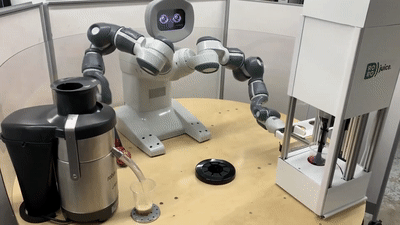
Robojuice, a startup using robots to make and sell juices and smoothies, announced today that it plans to open up its first location this spring. The first juice robo will be installed at Stanford University in the April/May timeframe.
The Robojuice is notable for a couple of reasons according to Robojuice CEO and Co-Founder Igor Nefedov, whom I spoke with by phone today. First, it is using a humanoid-style robot with two articulating arms to interact with and serve customers. “People are more used to ordering from people,” Nefedov said, explaining that in addition to familiarity, there is an entertainment value to Robojuice’s presentation.
Another differentiator is that Robojuice will use hydraulics instead of motors to move its robotic arms. Nefedov said this will make the Robojuice a much cheaper alternative to something like rival smoothie bot, Blendid.
The Robojuice can make a drink in 30 seconds. It will offer 15 flavors and sell drinks for around $5 to $6. The first robot will only have on-machine ordering capabilities, with a mobile app to come at some point later. The company plans to build out its own chain of Robojuice locations and offer franchises for $30,000.

Robojuice certainly isn’t alone in the automated drink space. The aforementioned Blendid has its articulating arm making smoothies at the University of San Francisco and Sonoma State University. Over in Europe, Alberts ditched the articulating arm in favor of embedded automation for its smoothie vending machine.
It’s worth noting that like Cafe X and Macco Robotics, Robojuice is all-in with the humanoid form factor. Unlike something like Briggo, which embeds its automation in a box, the mechanics of Robojuice are on full display. Like Robojuice, Cafe X still uses its articulating arm in part because of the theatricality (it used to wave to passers by), and Macco Robotics has the grand vision of building a full-on autonomous humanoid kitchen robot to help with cooking.
As I’ve written before, the word “robot” comes with all kinds of baggage, and food robots have been going through growing pains as of late. Cafe X closed three of its locations, and Zume Pizza, which used robotic assistants, shut down as well.
For Robojuice to survive, it will need to raise a few more robo-bucks. As of now, the company has only raised an undisclosed pre-seed round of financing. There are a lot of schools and other high-traffic locations for automated food experiences like Robojuice, but it will take money to scale up and reach them.